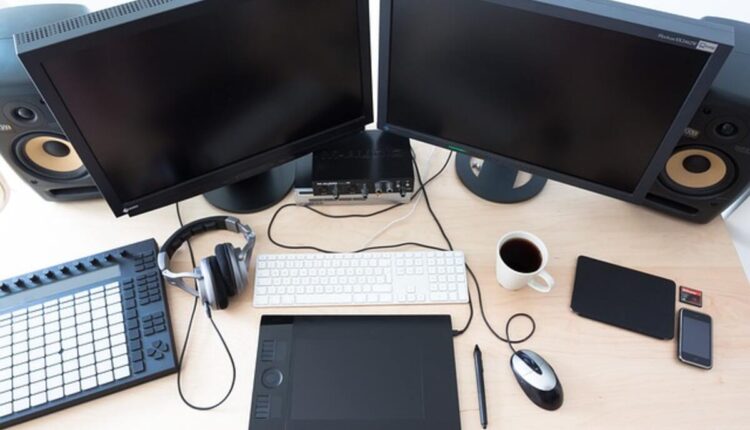DIY or Service Contract?
Make sure the speakers are still under warranty before doing anything else. If this is the case, forget about attempting any fix on your own and, instead, call the manufacturer. The full coverage of the guarantee will be voided if you try repairs on your own.
The issue would probably be minor most of the time. Either the power cord is disconnected, or the speakers are not plugged into the correct outlet. Verify the integrity of all connections. You could try a different wall outlet to see if that helps. If the speakers are USB powered, you could try using a different USB port, as some may malfunction. Check to make sure the USB cable is not broken.
When you’ve ensured everything else, rerun the sound test. Whether using a 1/8-inch TRS cable to link your computer and speaker, try plugging it back into the computer’s audio jack to see whether the issue is resolved. There is a green jack for audio output.
Having Problems with the Hardware
There’s a good chance the underlying hardware is where the issue lies. Rather than tinker with the motherboard, you may need to acquire a new add-on sound card or a cheaper one, depending on whether the problem is a lack of software or hardware required to run the excellent add-on card or a workable onboard sound card. If you have tinkered with the computer’s BIOS, you might have accidentally turned off a setting necessary for the onboard sound card to function correctly.
It’s possible that the self-powered USB speakers are to blame for the hardware issue. Unplugging it and trying it in a different USB port is your best bet. Swap out the power supply and see whether the problem follows the speakers or the wires. You may be dealing with a software-related issue if you’ve eliminated all potential hardware-related causes.
Verify Software for Errors
If you want to ensure your loudness system functions correctly, follow these steps.
Get to the Desktop, then select Start, and then Control Panel.
Choose the Audio Output Devices and Playback section.
The last thing to do is to look at the volume settings.
If the field is grayed out, it means that either no playback device is installed on your computer or that your hard disk is corrupt and needs to be replaced to restore sound.
If the area is in use, on the other hand, make sure the Mute button is unchecked and the Device Volume is set to the appropriate level.
Head to the Sounds panel for additional tasks when you’ve finished here.
Select the ‘Sounds’ menu option.
The ‘No Sound’ scheme must be deselected by clicking ‘Sound Scheme.’
Select “Windows Default” from the list of available sound schemes before you try out your adjustments. Any speaker icons on the ‘Program Events’ tab will take you to the appropriate sound settings for your program. To hear the music, click the left button and press play. There could be a software issue if it doesn’t fix the problem.
If you have more than one playback device installed on your computer, you can change the default to use your sound card by selecting the ‘Sound Playback’ option on the Audio tab.
You might want to look at your audio drivers if it doesn’t work.
Locate the My Computer shortcut in the Start menu.
Select Properties by right-clicking the My Computer icon.
To access the Device Manager Button, select the Hardware Menu.
Browse the Game Controllers, Video, and Sound sub-menu.
To locate the sound card, it was undoubtedly named something that included the word “Audio” in the filename. When a ‘!’ appears next to the excellent card icon, it means there was a mistake with the drive.
If you double-click, the audio device will open in a new window. If the correct device is chosen, a Drivers tab will appear.
Just hit the Driver Update button and follow the on-screen instructions. This ensures you have the most up-to-date driver for your computer.
If your driver is the most recent version, you can remove it and restart your PC to have the latest driver automatically reinstalled. The maker of your PC will be able to direct you to the most up-to-date audio drivers available online.
Extreme Measures
The gadget needs to be troubleshot as well. The Drivers page features a troubleshooting symbol for Microsoft Windows. It will walk you through the steps once you choose it.
Last but not least, you can check out the sound card. You need only disconnect everything from the PC except the power cord. Touch the metal enclosure inside the CPU that houses the power supply. Any static charge your contact may have caused has dissipated, so you can unplug the power cord. Your computer’s sound card is housed within and corresponds to the jack on the outside. The next step is to detach it and reconnect it. Reconnect the wires and restart the computer after inserting the sound card into its proper slot.
Tips
Don’t try to remove or detach the motherboard’s integrated sound card. There’s a risk that you’ll mess up the motherboard, which would require a costly replacement. A separate PCI sound card might be what you need. Technology seems to be two steps ahead of you in today’s environment. If you find yourself in this circumstance, your best bet is to rent any modern computer parts you may require. This will allow you to get needed support and save you time overall. Since founding in 1996, AA-Rental.com has been ready to assist with speaker rental requirements.
Read also: The Best Way To Fix A Freezer Which Usually Isn’t Freezing.

